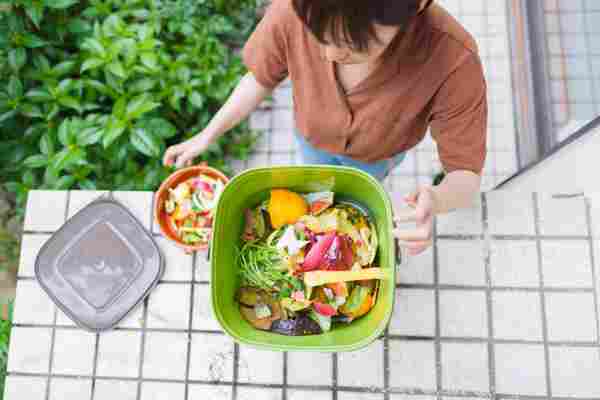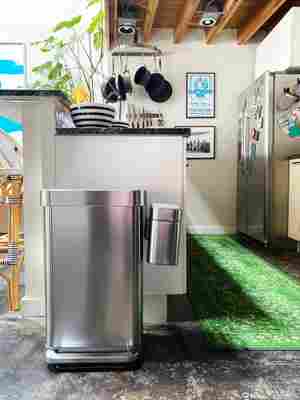If You Have a Window, You Can Compost — Here’s How to Get Started Right Now

Food waste is a serious problem. Between restaurants throwing out food, the leftovers that spoiled in the back of your fridge, and produce that didn’t get sold early enough, a lot of food is ending up in garbage cans across the United States, and being toted to landfills shortly after. Over 20 percent of all landfill waste in the United States is made up of food waste, according to the Environmental Protection Agency figures for 2018 . That amounts to 63.1 million tons of food, much of which could be turned into a renewable resource through the power of composting.
You may think composting is something only farmers and commercial facilities do, but the reality is that everyone can get involved in composting, and doing so isn’t as intimidating — or as time-consuming — as you might think it is.
What is composting and why should you compost?
Essentially, composting is taking decomposable waste materials like food scraps, leaves, yard trimmings, and paper, and giving them some assistance in breaking down. Composting is important for the environment because it diverts food waste from landfills, where it would break down anaerobically — or without air — which leads to methane and other greenhouse gasses being released into the atmosphere , thereby contributing to global warming.
Composting, on the other hand, is an aerobic process that doesn’t release greenhouse gas as food breaks down, and turns all those food scraps into a resource that can be used again. To get a bit scientific, the technical term for composting is “managed aerobic decomposition,” Rick Carr, the farm director at Rodale Institute , tells Apartment Therapy. This means that composting is the act of managing food waste and other compostable materials and letting oxygen-requiring microbes break them down organically.
In addition to being good for the environment, composting may also help you save money. In areas where trash collection is priced by the pound, composting your food waste will help you cut down on trash weight and save money on your waste collection bill.
How much work does composting take?
While many people think composting takes a ton of work, Rebecca Louie, a certified Master Composter and the author of “Compost City: Practical Composting Know-How for Small-Space Living ,” asserts that’s a myth. “ Composting methods are actually super passive because the things that are doing the work are the microbes, the little insects, and other creatures like worms that are breaking it down,” she says. “Your job is to occasionally feed your system, and make sure it has the right balance it needs, which is just a periodic check-in.”
What are “greens” and “browns,” and what is the difference between them?
A lot of composting lingo refers to a mixture of “greens” and “browns” as things you need to produce compost effectively. “Greens” are high-nitrogen materials like banana peels, vegetable scraps, and other food waste, while “browns” refer to high-carbon materials like leaves, yard trimmings, straw, paper, and cardboard. According to Carr, having the right ratio of greens and browns ensures optimal, fast decomposition, without worry of odor or pests. “When the right ratio occurs, the microorganisms in all of the material are going to start going to work on the food waste — the green material — to break it down,” he says.
After the microorganisms have been working on the food waste for some time, Carr says that the leftover product will look like dark, dry soil with an earthy odor. Once your compost reaches this point, it’s ready to be used on indoor plants, gardening projects, your lawn, or even in local tree beds as an added boost of nutrients to the soil and the plants living in it.
What Master Composters Want Beginners to Know
According to Carr, the most important tip for successful composting is a technique called lasagna layering. This process consists of creating a nest of browns on the bottom of your compost bin or pile, and then layering food waste in the middle, leaving a few inches of leaves, straw, and other browns around the perimeter. Then, be sure to cover any food waste with another layer of browns, and never leave any food scraps showing. This will ensure no bad smells come from your compost pile, and that it doesn’t attract any bugs or other pests.
This of course, means that you need to collect a lot of leaves, straw, wood shavings, and yard clippings before you start composting. Carr recommends about five gallons of browns per one gallon of food waste, so if you don’t have the space to hold six gallons of material at one time, adjust your amounts according to that ratio.
Louie recommends that beginner composters start with a small volume of compost at first . “It’s better to start small and succeed and go big and fail,” she says. “It’s much easier to do it right and scale up, get better, learn than it is to be super ambitious, try to compost everything at once and then create some of the conditions that are less favorable and a lot less fun to deal with.”

How to choose the composting system that’s right for you:
There are plenty of composting systems, and there’s really no one right system for everyone — but the type of composting you choose should take into account the amount of space you have and the amount of work you want to put in.
Community Composting
The easiest type of composting that’s available to people in cities or towns is often community composting, which consists of collecting your food scraps and dropping them off at a site that composts them for you. This kind of composting allows you to actively engage with your community, and is less work for you since you don’t actually have to manage a compost bin or pile. Call up your local city hall or community center to see if they have leads — if you live near a community garden, someone tending the ground might have answers for you, too.
If your town doesn’t have a community composting program, you can absolutely take composting into your own hands at home, such as through backyard composting, which consists of layering greens and browns in a pile, bin , or trench in your yard. Carr says this type of composting is ideal for folks who want to be ambitious and compost gallons of food waste at a time.
Window-Box Composting
If you live in an apartment and don’t have a backyard for a big compost heap, you can still compost! Louie suggests that people who want to compost in tighter living quarters try using a window box. This style uses the same idea of a compost bin or pile, just on a smaller scale. Any store-bought or window box will work, but there are a few things to keep in mind before you start. Louie recommends covering any food scraps with four to six inches of soil to keep out smells and pests — and to remember to keep the moisture level up by watering your compost.
“People forget that water is part of the process,” she says. “Window boxes often get very dry and water helps the microbes do the work that they’re going to do.”
Vermicomposting
Another option for small spaces is vermicomposting , which is particularly ideal for the curious composter, parents with children, and folks who simply like the idea of taking care of animals. Vermicomposting consists of using worms — usually of the red wiggler variety — to help break down food waste. The result is a finished compost called vermicasting, or worm poop, that can be used as a nutritious soil amendment. Vermicomposting happens at a pretty small scale though, with beginner bins normally consisting of about one pound of worms. Louie says to only expect to be tossing about a pint of food scraps in the bin at a time, and waiting until those scraps are pretty much completely broken down before feeding your worms again.
Bokashi Fermentation
Bokashi fermentation is the last option for small-scale composting. This method consists of layering food scraps and Bokashi flakes full of beneficial microbes in an airtight bucket. The perk of Bokashi is that you can ferment pretty much anything safely and effectively, but if you don’t have a backyard, you will need to have a partner site where you can bury the fermented materials to help them finish breaking down. Louie says that folks who select Bokashi fermentation as part of their composting routine should expect some fermentation odors when you open the bin.
How much is my compost supposed to smell?
According to Louie, many people believe composting is really smelly, but that doesn’t have to be the case. If you create biofilters in your composting system, like layers of browns or a few inches of soil on top of food scraps, you’ll avoid any odor. Louie also recommends keeping track of moisture levels in your compost bin or pile.
“When things get really wet, sometimes that’s when things can start compacting and anaerobic microbes kick in,” she says “And that’s where you might get some of that sour smell.” If your compost bin is too wet and starts to smell bad, Louie says you should add more browns or give your bin a drying-out session outdoors if possible.
What can and can’t be composted?
Any fruit or vegetable scraps, grains, paper, plant trimmings, and even leftover food can be composted. While there is some debate among composters about meat, dairy, and oily food products, Carr says that these things are safe to compost if done correctly. “It’s well-known among master composters that meat, dairy, and bones break down pretty easily, without trouble, as long as you know how to manage, troubleshoot, and prevent issues,” he says.
Your comment